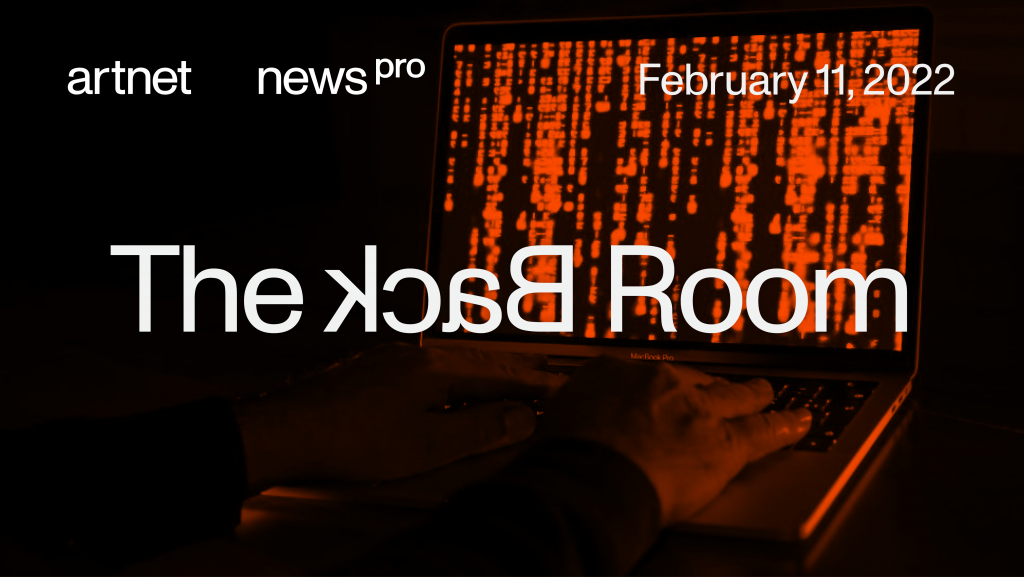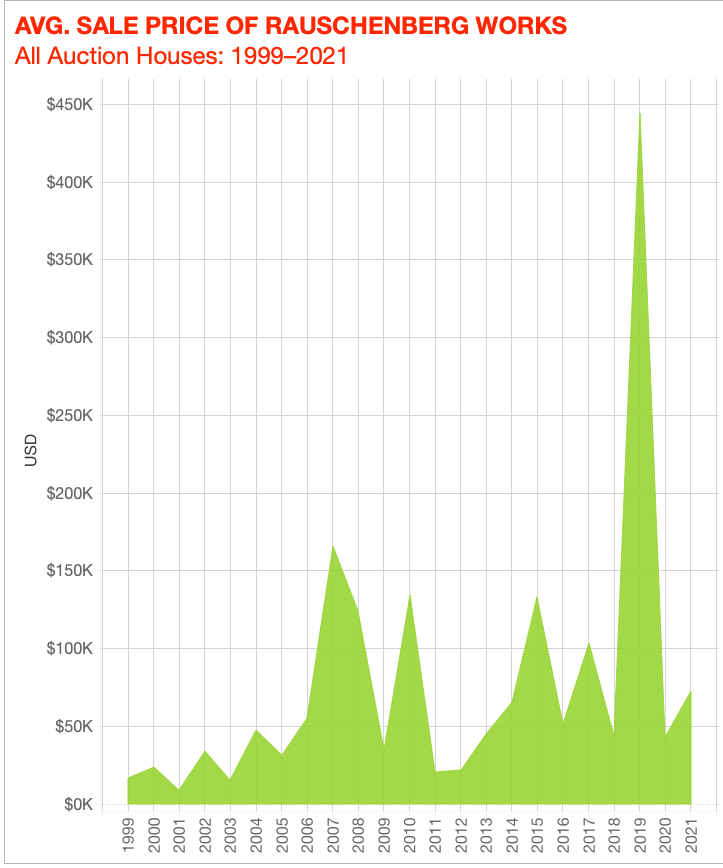The Back Room
The Back Room: The Great Online Unknown
This week in the Back Room: a crypto art identity crisis, Rauschenberg’s auction paradox, a first-day sell-out in Art Basel's OVR, and more.

This week in the Back Room: a crypto art identity crisis, Rauschenberg’s auction paradox, a first-day sell-out in Art Basel's OVR, and more.

Tim Schneider

Every Friday, Artnet News Pro members get exclusive access to the Back Room, our lively recap funneling only the week’s must-know intel into a nimble read you’ll actually enjoy.
This week in the Back Room: a crypto art identity crisis, Rauschenberg’s auction paradox, a first-day sell-out in Art Basel’s OVR, and much more—all in an 8-minute read (2,197 words).
__________________________________________________________________________

The Bored Apes used as avatars by Yuga Labs cofounders Wylie Aronow (fka Gordon Goner) and Greg Solano (fka Gargamel). Courtesy of Twitter.
Would art and commerce be better off if everyone involved could remain anonymous forever? We were reminded last weekend that many boosters of NFTs, crypto, and the metaverse think so—and the turf war over the outcome puts high stakes on an art world increasingly bound up with tech.
The flashpoint arrived when Buzzfeed News revealed the identities of two of the four founders of Yuga Labs, the entity behind the hugely popular, wildly expensive Bored Ape Yacht Club NFT project. This week, I macheted the underbrush around the story and the larger questions, starting with the basics…
What on Earth Is Bored Ape Yacht Club?
The most popular, most expensive PFP (“profile pic”) NFT project out there. It’s made up of 10,000 crypto-certified images, each depicting a cartoon ape with a unique combination of attributes, plus a backstory about a community of wealthy primates killing time in a swamp clubhouse. (More context available in this explainer.)
How Popular and Pricey Are the Bored Apes?
Since BAYC debuted in April 2021, the price for a single ape has swung from around $300 to no less than $250,000 today. The entire series has a market cap above $3.1 billion, per crypto tracker DappRadar.
Celebrity owners span generations and demographics. For the Boomers, Gwyneth Paltrow, Paris Hilton, and Jimmy Fallon are all in the club. For the younger set, the same is true of streaming-era rap sensations Lil Baby and Lil Durk. And both crowds will probably(?) recognize proud BAYC owner Eminem.
Is There More to Yuga Labs Than BAYC?
It has made related PFP projects, like the Bored Ape Kennel Club. But investors think the company has potential to go much bigger. The Financial Times reported last week that venture-capital behemoth Andreessen Horowitz was exploring a “multimillion-dollar stake” that would value Yuga Labs at between $4 billion and $5 billion.
Who Got Unmasked, and How?
Until last Friday, Yuga Labs’s four founders were only known as two self-described “literary nerds,” calling themselves Gargamel and Gordon Goner, and two engineers going by Emperor Tomato Ketchup and No Sass.
Buzzfeed News revealed that Gargamel is 32-year-old Greg Solano, and Gordon Goner is 35-year-old Wylie Aronow—both Florida natives who transitioned from writing careers to crypto ambitions.
Journalist Katie Notopolous found that Yuga Labs’s articles of incorporation showed the company being registered in Delaware last February “with an address associated with” Solano. She then followed a trail of public documents connecting Solano to Aronow, whose personal backgrounds match details divulged in past interviews.
How Did Those Revelations Turn Into a Flame War?
Yuga Labs’s CEO confirmed Notopolous’s conclusions were correct. Solano and Aronow outed themselves on Twitter shortly thereafter, framing Notopolous’s report as having been “doxxed,” the parlance for having all of your personal details dumped onto the internet, usually by a bad actor.
That loaded verbiage launched an army of crypto bros into outraged action. They portrayed Buzzfeed News’s actions as “disgusting” and “dangerous,” while labeling Notopolous a “whore for clicks” and threatening to release personal details about both her and her parents.
Why Is Anonymity Sacred in Crypto Land?
Because blockchains are supposedly the foundation of Web3, the much-discussed, user-owned third phase of the internet that aspires to right all kinds of societal wrongs, including discrimination and mass surveillance.
The social argument for anonymity goes something like this: Although it’s largely effective to hold people accountable by documenting and tracking their physical identity, doing so also imposes unfair costs on many individuals (see: people from historically marginalized ethnic, class, and gender groups).
Blockchains can solve this, theoretically. Once a permanent, distributed, universally accessible online database can verify and record every transaction, pledge, completed task, and communication coming from a single digital presence, our off-screen identities no longer matter. Who you are can be reduced to what you do. That means a crypto-verified alter ego could liberate individuals from all kinds of prejudice and harm.
Are There Precedents for the Use of Widespread Online Anonymity?
There is turn-of-the-millennium proto-metaverse Second Life, which remains active today, with a user base of around one million. But it’s a splash of cold water.
After more than 20 years, only “a small fraction of adults” in Second Life have chosen to use pseudonymous avatars long term, said a major investor in the project. Its creative mastermind, Philip Rosedale, added that grown users have generally only opted for a new digital body and identity for reasons that are “not common,” like living under authoritarian rule, living with disabilities, and living in a rural area divorced from any offline creative ferment.
Most other users preferred to be known on the platform by their actual names, and to represent themselves as avatars that shared their physical traits—not a great indicator for widespread adoption of avatars and aliases.
But Millions of People Worldwide Live Under Authoritarian Rule, Right?
Yes, but how many of them have reliable access to today’s internet? For those who do, how restrictive do regimes tend to be about the use of apps created abroad, like Facebook and Twitter? Why should we expect these groups will be able to “live” in the metaverse, a more technologically complex and all-encompassing version of the web spearheaded by U.S. tech giants?
Fair Point. So What Did the BAYC Scandal Teach Us About All This?
Well, Solano and Aronow don’t seem to be part of any marginalized or threatened identity groups, and I’m willing to bet that a lot of their defenders aren’t either.
That seems new… until you learn from the Second Life brain trust that an unusually high proportion of the users who favor alter egos are the platform’s most active “creators,” or the few people building the most imaginative elements of the virtual world.
The BAYC unmasking also shows how hard it is to keep your identity anonymous once someone really wants to know—a reason many people likely never try to hide in the first place. And based on the large number of Twitter users bombarding Notopolous with abuse and threats under PFPs and pseudonyms, the idea that a metaverse full of avatars and aliases will end racism, sexism, classism, misogyny, and more looks naive at best.
__________________________________________________________________________
Blockchain cannot fix a complex social problem like ingrained bias at scale. But the crypto-camouflaging of identities can, and will, make it more complicated to know who, exactly, you’re dealing with in Web3. As a rule, that kind of complexity ultimately favors the wealthy, powerful, and ill-intentioned in any system.
Unless we want the next generation of technology to provide even more cover to the types of people who have wreaked havoc on art and commerce through old-fashioned cloaking devices like middlemen and shell companies, we’d better start thinking about how to build some guardrails into the metaverse—fast.
____________________________________________________________________________

If you can’t read spanish, this is Swizz Beatz wearing a jacket that says “among individuals, as well as among nations, respect for the rights of others is peace.” Seriously! It says that. Photo: DON EMMERT/AFP via Getty Images)
In the latest Wet Paint, budding mega-collector Kasseem “Swizz Beatz” Dean became the newest culture-sector luminary working (presumably, for a premium) to rehabilitate the global image of Saudi Arabia via the wonders of social-media sponcon.
Here’s what else made a mark around the industry since last Friday morning…
Art Fairs
The French modern-art and antiques fairs Fine Arts Paris and La Biennale are merging into one umbrella event debuting at the Carrousel du Louvre this fall (November 8–13), before heading to the Grand Palais Ephémère in 2023 and renovated Grand Palais in 2024. (Press release)
Auction Houses
Galleries
Institutions
NFTs and More
____________________________________________________________________________

© 2022 Artnet Worldwide Corporation.
Robert Rauschenberg’s market is a paradox. His deserved reputation as a titan of postwar American art resulted in a deep supply of sellable objects, and yet his most desirable works—the 1960s-era “Combines”—were largely snapped up by museums decades ago, ensuring they almost never reach the auction block.
This tension has twisted his public-market history into a strange shape reflected in the chart above.
For the artist’s full run through “The Appraisal,” click through below.
____________________________________________________________________________
“Even the name ‘collector’ should be redefined, as it should come with some responsibilities, just like everyone else in the ecosystem… To just be able to part with money for objects you love cannot be enough.”
—Ugoma Ebilah, founder of Bloom Art gallery in Lagos, on the need for more holistic thinking about patronage in Nigeria’s budding contemporary-art scene. (Artnet News Pro)
____________________________________________________________________________

Sable Elyse Smith, Coloring Book Painting 83 (2022). Photo by Charles Benton. Courtesy of the artist and JTT, New York.
____________________________________________________________________________
Price: $50,000
Acquired at: Art Basel OVR: 2021
Sale date: Wednesday, February 9
If you weren’t trawling Art Basel’s OVR: 2021 when it went live this Wednesday, it’s already too late to secure anything from its hottest virtual booth: the solo presentation of works by Sable Elyse Smith at New York’s JTT.
Smith’s work has been turning more and more heads over the past few years. She is an alum of the prestigious Studio Museum residency program, and she was one of the standout talents in the lauded “Marking Time: Art in the Age of Mass Incarceration” at MoMA P.S.1.
But her career accelerated to hyperspeed in the past month, when she became one of only two artists selected to this year’s editions of both the Venice Biennale and the Whitney Biennial. (The other to earn the honor is Wu Tsang, who appears in the latter show as part of the artist duo Moved by Motion.)
JTT dedicated its Basel OVR space to eight of Smith’s “Coloring Book” paintings, which reproduce pages from activity books made for children thrust into contact with the U.S. legal system. The artist then intervenes with her own marks to disrupt the books’ loaded subtext about race, class, and other factors affecting perceptions of criminality and justice.
“While this series focuses on how children learn about basic ideas of guilt and innocence, it also challenges how any adult might hold tightly to their understanding of either or both,” said JTT founder Jasmin Tsou.
Plenty of buyers were eager to accept that challenge. Priced at $35,000 for single-panel works and $50,000 for diptychs, all eight works sold on opening day. If you’re hoping to find other gems online, Art Basel OVR: 2021 continues through February 12.
____________________________________________________________________________
With contributions by Naomi Rea.